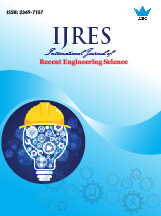The use of Cooperative Learning of Jigsaw-Type and Make a Match Type to Improve Students' Activity
 |
International Journal of Recent Engineering Science (IJRES) |  |
| © 2017 by IJRES Journal | ||
| Volume-4 Issue-1 |
||
| Year of Publication : 2017 | ||
| Authors : Nur Aini Wahyu Hidayah, Suharno, Mintasih Indriayu |
||
| DOI : 10.14445/23497157/IJRES-V4I1P108 |
How to Cite?
Nur Aini Wahyu Hidayah, Suharno, Mintasih Indriayu , "TThe use of Cooperative Learning of Jigsaw-Type and Make a Match Type to Improve Students' Activity," International Journal of Recent Engineering Science, vol. 4, no. 1, pp. 33-38, 2017. Crossref, https://doi.org/10.14445/23497157/IJRES-V4I1P108
Abstract
This research aims to improve the activity of third grade students at elementary school 02 of Troketon district Klaten Indonesia by applying a cooperative model of Jigsaw type and Make a Match type. This research is a classroom action research conducted at elementary school 02 Troketon Indonesia. The research subject is the students grade III that consists of 25 students. This research is conducted in three cycles, data collection techniques using observation and documentation. The validity of the data used was sources triangulation and method triangulation. The analysis of the data used is qualitative analysis and comparative descriptive analysis. The results of this classroom action research show the students activity at the time of pre-action no students entered to the active category and while in the cycle I, the students percentage who entered to the active category was 12%, in cycle II the students activity percentage increased to 32% , and in cycle III the students activity percentage increased to 76%. Based on the results of the research, it can be concluded that through the use of cooperative learning model of Jigsaw type and Make a Match type can improve the students’ activity of the students grade III of elementary school 02 Troketon district Klaten Indonesia.
Keywords
students’ activity, jigsaw, make a match
Reference
[1] Susanto, Ahmad. 2014. Pengembangan Pembelajaran IPS di Sekolah Dasar. Jakarta: Prenamedia Group
[2] Lee, Hyun-Hwa&Jean D. Hines. 2012. Incorporating Active Learning and Student Inquiry into an Introductory Merchandising Class. International Journal of Higher Education.2 (1). 55-69. http://files.eric.ed.gov/fulltext/EJ1081466.pdf. Date retrieved: March 6, 2016
[3] Akınoğlu, Orhan & Ruhan Özkardeş Tandoğan. 2007. The Effects of Problem-Based Active Learning in Science Education on Students Academic Achievement, Attitude and Concept Learning. Eurasia Journal of Mathematics, Science & Technology Education (3) 1. http://ejmste.com/v3n1/EJMSTEv3n1_Akinoglu.pdf. Date retrieved: March 9, 2015
[4] Soltanzadeh, Liele, Seyed Reza Nazari Hashemi and Sakineh Shahi.The effect of active learning on academic achievement motivation in high schools students. Archives of Applied Science Research 5 (6).http://scholarsresearchlibrary.com/aasr-vol5-iss6/AASR2013-5-6-127-131.pdf. Date retrieved: March 14, 2016
[5] Hackathorna, Jana, Erin D. Solomonb, Kate L. Blankmeyerb, Rachel E. Tennialb, and Amy M. Garczynskib. 2011. Learning by Doing: An Empirical Studyof Active Teaching Technique. The Journal of Effective Teaching.11 (2). 40-54. http://uncw.edu/jet/articles/Vol11_2/Hackathorn.pdf. Date retrieved: March 14, 2016
[6] Taniredja, Tukiran, Efi Miftah Faridli and Sri Harmianto. Model-model Pembelajaran Inovatif and Efektif. Bandung: Alfabeta
[7] Johnson, David W, Roger T Johnson, and Edythe Johnson Holubec. 2010. Colaborative Learning: Strategi Pembelajaran Untuk Sukses Bersama. Diterjemahkan oleh Narulita Yusron. Bandung: Nusa Media
[8] Mengduo, QIAO & JIN Xiaoling. 2010. Jigsaw Strategy as a Cooperative Learning Technique: Focusing on the Language Students. Chinese Journal of Applied Linguistics (Bimonthly).33 (4). 113-125
[9] Naomi, Mbacho W, Prof. Bernard Nyingi Githua, PhD. 2013. Effects Of Jigsaw Cooperative Learning Strategy On Students‟ Achievement In Secondary SchoolMathematics In Laikipia East District Kenya. Asian Journal Of Management Sciences And Education 2 (3). http://www.ajmse.leenaluna.co.jp/AJMSEPDFs/Vol.2(3)/AJ MSE2013(2.3-18).pdf. Date retrieved: March 14, 2016
[10] Adams, Francis Hull. 2013. Using Jigsaw Technique As An Effective Way Of Promoting Cooperative Learning Among Primary Six Pupils In Fijai. International Journal of Education and Practice, 1 (6). 200-210
[11] Huang, Yueh-Min, Yi-Wen Liao, Shu-Hsien Huang & HsinChin Chen. 2013. A Jigsaw-based Cooperative Learning Approach to Improve Learning Outcomes for Mobile Situated Learning. International Forum of Educational Technology & Society. Journal of Educational Technology & Society (17) 1. http://www.ifets.info/journals/17_1/12.pdf. Date retrieved: March 6, 2016
[12] Rusman. 2013. Model-model Pembelajaran Mengembangkan Profesionalisme Guru. Jakarta: PT. Raja Grafindo Persada
[13] Huda, Miftahul. 2013. Model-Model Pengajaran and Pembelajaran. Yogyakarta: Pustaka Pelajar
[14] Stack, Steven. 2015. Learning Outcomes in an online vs traditional course. International Journal for the Scholarship of Teaching and Learning.9 (1). 1-18
[15] Ito, Hiroshi & Nobuo Kawazoe. 2015. Active Learning for Creating Innovators: Employability Skills beyond Industrial Need. International Journal of Higher Education.4 (2). 81-91
[16] Pundak, David, Orit Herscovits, Miri Shacham and Rivka Wiser-Biton. 2009. Instructors' Attitudes toward Active Learning. Interdisciplinary Journal of E-Learning and Learning Object.5. 215-232. http://www.ijello.org/Volume5/IJELLOv5p215- 232Pundak669.pdf. Date retrieved: April 18, 2016
[17] Afayombo, Grace. 2014. Enhancing Learning Outcomes in Psychology through Active Learning Strategies in Classroom and Online Learning Environments. International Journal of Learning & Development. International journal of Learning & Development (4) 3. http://www.macrothink.org/journal/index.php/ijld/article/vie wFile/6703/5504. Date retrieved: March 6, 2016
